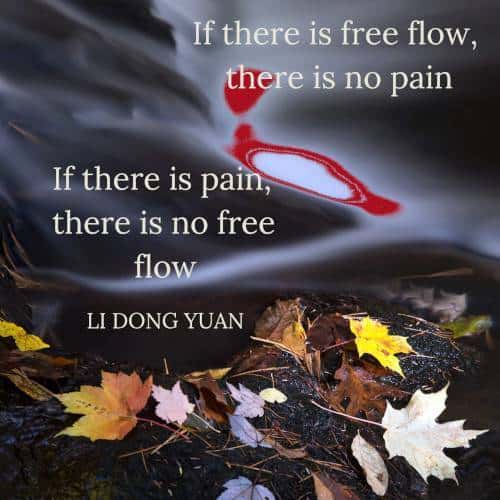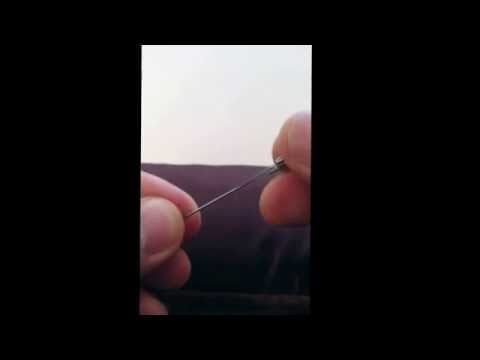Acupuncture is a little weird right? Someone sticks a bunch of needles in you and that makes you feel better. How is that even possible?
Learn about acupuncture as you follow this conversation between Qi Bo and Huang Di. These two characters from one of our most ancient medical manuscripts, the Huang Di Nei Jing, have visited the modern age to answer your questions (press the 3 orange dots on the right at any stage to bring them up) about acupuncture.
Go here if you are looking for acupuncture in Melbourne.
iMessage with Huang Di (Yellow Emperor)
Hey Qi Bo, it’s been a while! I have a few questions to fire at you
Of course, where do you want to start?
Maybe we could start at the beginning
What is acupuncture?
Great question! There are 3 basic points to know about acupuncture
Acupuncture is:
- A treatment method of Oriental medicine
- The insertion of fine acupuncture pins (filiform needles)
- Many different styles of practice
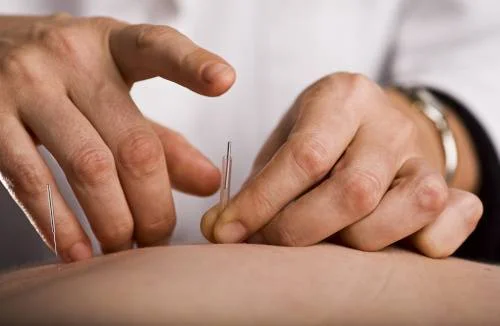
Can you say a little more about that?
Acupuncture is a treatment method of Oriental medicine. It is one of many tools that may be used alongside Chinese Herbal Medicine, Moxibustion, Cupping, Gua Sha, Massage, Dietary advice and Exercise therapy.
An acupuncturist will insert very thin acupuncture pins into specific acupuncture points. Since our time, over 2000 years ago, classical Oriental texts have discussed the use of acupuncture.
Of course! We would always refer to acupuncture as Zhēn Jiǔ (针灸). This included both needling and moxibustion.
You are right. We should consider both techniques in our acupuncture definition. But let’s leave moxibustion for a different conversation.
OK, but let’s not forget!
Of course!
What is stilostixis?
The term stylostixis arises from the Greek word stulos (pointed instrument) & stixis (mark). It refers to the insertion of needles into the skin at specific points for medical treatment. It is thus synonymous with acupuncture ie they both describe the same practice.
Did you know that throughout history, there have been many different family lineages and style of practice? Variations arose in different regions and countries.
In modern-day practice, the most well-known style of acupuncture is TCM acupuncture. Traditional Chinese Medicine, or TCM, is the basis of most practitioners preliminary education.
Following this many may find a specific style of practice that resonates with them. This then often becomes the focus of their post-graduate study.
OK great, thanks for the refresher. I think I have an idea of what acupuncture is again.
Can I ask a follow-up question?
Go right ahead
What does acupuncture do?
Oh, that question! There are a few ways to answer that, but put simply acupuncture works to:
Reduce pain
Relieve obstructions
Restore functional health in the body
Relax the nervous system
Sounds fairly straight forward. I’m sure there is more to know about it than that if I want to understand how acupuncture benefits health!
Of course! This famous quote from historical Chinese Medicine master Li Dong Yuan sums it up well
I think he captures the essence of what acupuncture does quite well. People use acupuncture for pain often as it benefits circulation by removing obstructions. This helps to reduce their pain.
What are the benefits of acupuncture?
Acupuncture therapy involves not simply the treatment of symptoms. It attempts to understand the root imbalance underlying your individual health presentation. A common benefit is that people generally feel relaxed after a treatment.
It works holistically to create a better quality of health and thus can deal with a large range of conditions. As a drug-free treatment option, it has become more popular in this age of poly-pharmacy.
I can’t argue with being more relaxed!
There is a range of conditions for which acupuncture has been shown to be effective. The team that compiled the Acupuncture Evidence Project made a great collation of these. You can search through this summary for more info.
I’ll have a look through that later
People seek acupuncture for a wide variety of reasons. Pain is the most common reason that people seek an acupuncture practitioner.
Around Spring, hay fever and sinus problems are often prominent in the clinic due to the famous Melbourne plane trees. This can for many be accompanied by migraine or tinnitus.
Do people find acupuncture benefits other health issues?
With modern life stress, depression and anxiety are commonly present for people. Acupuncture is a service that can complement other therapies such as counselling.
People also seek the help of a Chinese Medicine practitioner for menstrual and pregnancy issues as well as IVF support. Acupuncture is often used as part of labour preparation. Visits to an acupuncturist are common to assist with labour induction.
So acupuncture has lots of benefits then by the sounds of it.
Why do many people use acupuncture for pain?
Pain is usually the motivating factor for people to finally seek an acupuncturist to get treatment for their health issues. Thankfully, acupuncture is great at helping to manage a wide variety of pain presentations
Pain is simply one of the ways in which the body signals that there is a deeper dysfunction within which needs addressing.
Tweet it Out
You are right, that Li Dong Yuan fellow certainly does nail it!
Is that all that acupuncture does?
The body has a need for nutrients (Ying Qi – an aspect of Qi) and oxygen (Da Qi – a different aspect of Qi). This is distributed through the healthy circulation of blood (Xue) throughout the body.
When there are blockages to the free flow of Qi and Xue, diseases can occur as the body struggles to maintain harmony within itself.
Where do these blockages come from?
These blockages arise as a result of the body’s inability to deal adequately with stressful influences. These causes of diseases include:
- the external climate
- mental and emotional stress
- overwork
- poor diet
- lack of exercise
- toxic overload
- trauma
I assume that this is when those influences are stronger?
Yes. Or when the body is run down.
Ultimately, acupuncture benefits health by releasing obstruction and regulating the circulation of Xue and Qi. By addressing this circulation, all systems of the body are able to function better.
It sounds like acupuncture is a great drug-free approach to managing pain and health concerns. The health effects of acupuncture must be quite broad.
?
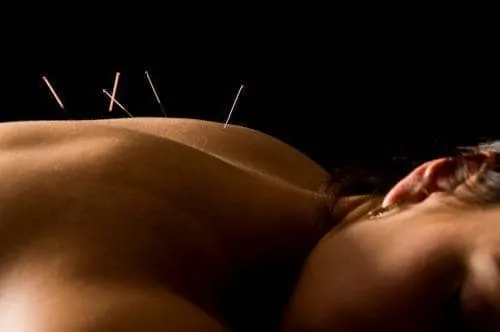
You can read more in this article about how people use acupuncture to treat pain.
In Chinese Medicine, we talk in the language of Yin, Yang, Five Elements etc to understand how acupuncture works.
I understand that in this modern age, they have a thing called scientific research. This uses a different language to describe the functions of the body. Do they use this to understand acupuncture?
Do you mean are they researching the question
How does acupuncture work?
Yes
By stimulating acupuncture points with acupuncture needles!
The theoretical model of Chinese Medicine on which acupuncture is based talks primarily in the language of Qi and Xue. These concepts hold some relation to Western descriptive models but are not an exact match.
A popular interpretation is that Qi refers to energy or the level of oxygen that is moving through our body. Xue is translated as blood and refers to the nutrients and minerals we need to sustain our physical being.
Modern research into the mechanisms of acupuncture has been conducted for decades. Many models have been explored including sensory nerve pathways, biochemical markers including opioid and non-opioid neuropeptides, neurotransmitters, effects on the central nervous system such as increased functional connectivity, decreased sympathetic (stress out) response and engagement of parasympathetic (chill out) activity. There is also the mechanical effects of stimulating release through the fascia (connective tissue).
Wow! That’s a whole lot of concepts. I can see the correlation of ideas there!
Yes. There are many factors which all team up to explain how acupuncture works. But no unifying theory has yet been determined within the Western medical model. Self-regulation of purinergic signalling is a recently discussed mechanism that offers to tie together many of these models.
What does all that mean?
Acupuncture works by helping to disperse and prevent blockages by releasing constrictions in the fascia (connective) tissue1.
This means the circulation of blood and fluids is improved. With this, all the chemical, hormonal and nutritive factors that are transported within can reach where they need.
This allows nutrients and energy to freely reach throughout the body, encouraging its natural healing potential to take over.
In turn, this allows the internal organs to restore healthy function. Thus a sense of wellbeing and relief to the symptoms is experienced.
So acupuncture is a circulatory medicine?
Yes!
Also it physically it rebalances the bodily structure and releases constriction in the muscle tissue. This mechanical release of constriction can be transmitted through the fascial network resulting in adjustments both locally to the site of needling, and distally elsewhere in the body such as the internal organs.
Some believe that these pathways through the fascial network are what we call the acupuncture channels.
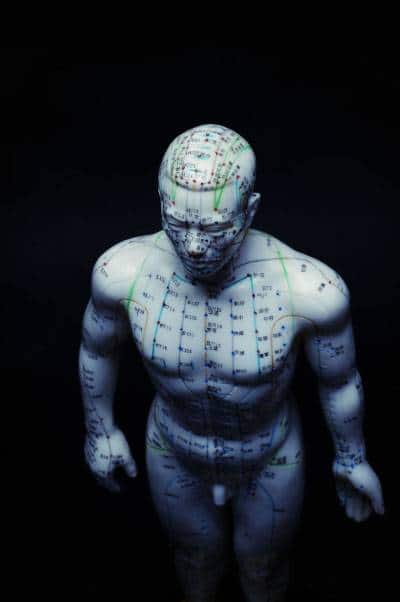
That seems like it could be a plausible modern translation of that concept!
As I mentioned as well, the insertion of an acupuncture pin stimulates sensory nerves, leading to effects on the central nervous system. This has been measured to decrease sympathetic and increase parasympathetic nervous system activity2.
This rebalancing of the autonomic nervous system explains the calm and relaxed sensation many people experience after an acupuncture session.
You mean their Shen is calmer?
Exactly!
Also, these nerve signals are transmitted to the brain, with multiple specific aspects of the brain being activated with the stimulation of each acupuncture point.
So it treats the whole body?
Yes.
Acupuncture also benefits circulation through causing the blood vessels to dilate3, thus increasing healthy blood flow to diseased areas of the body. Combined with the neurological stimulation, this lowers blood pressure4.
So modern research is basically saying that it makes Qi and Xue flow more freely?
Yes
Hasn’t Chinese Medicine been saying the for centuries?
Yes
Hmmm. Seems we were on to something!
You can look further into it at the TEAM Research or Evidence Based Acupuncture websites
Now I’m pretty strong and have a high pain threshold. But I’m going to ask this question – for a friend.
Sure
Does acupuncture hurt?
I think they wrote a song about that!
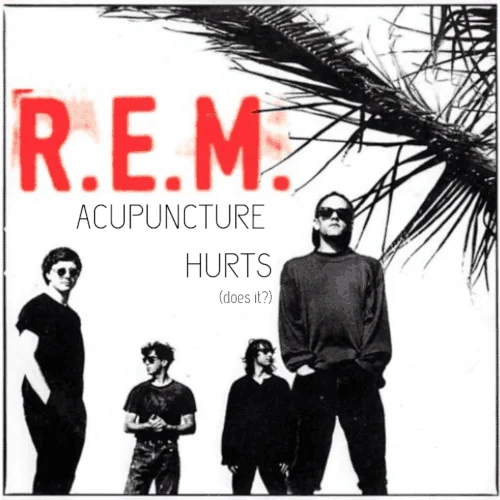
***groan***
No, but seriously….
Treatment with acupuncture generally does not hurt. Any discomfort felt should be temporary and is related to the technique used and the experience of the practitioner.
Does acupuncture hurt after treatment?
Well once acupuncture needles are removed, no they shouldn’t hurt you. They are disposed of immediately in a sharps container to keep you safe from any injury. So acupuncture shouldn’t hurt after treatment.
Occasionally your body may hurt a little after treatment. This generally should not happen and can be a sign that treatment was too strong or too much for that day.
Sometimes this may occur as the increased bodily awareness following treatment brings attention to areas that have been neglected through habituation.
Alternatively, the release of one area may allow a different area to call out for help, like the peeling of layers of an onion.
If there is discomfort following acupuncture treatment it is a good idea to communicate this with the acupuncturist as soon as possible.
OK I’ll remember to tell my friend that
What about the needles.
Do acupuncture needles hurt?
Upon insertion of an acupuncture pin, one might experience a temporary ‘mosquito bite’ prick, however, this should not last.
Any lingering sharp pain sensation can, and should, be removed through simply adjusting the depth and angle of insertion – often by just a few millimetres.
So I, I mean they, won’t feel anything after that then?
Not necessarily.
A sensation may be felt which is often described as a local aching, warmth or spreading feeling. The Chinese refer to this is Da Qi.
Sometimes this sensation of movement or release is observed in areas of the body far removed from where the pin is being inserted.
OK so tell me some more about these acupuncture needles that are used
How thick are acupuncture needles?
In modern-day practise acupuncture needles are usually in the range of 0.12 to 0.35 mm thick. Comparatively the average human hair is 0.075mm thick
So acupuncture needles are not too much thicker than a hair, wow!
Yes, it’s pretty amazing how thin a needle can be produced in modern times.
This image helps get an idea of the different gauges used in modern practice
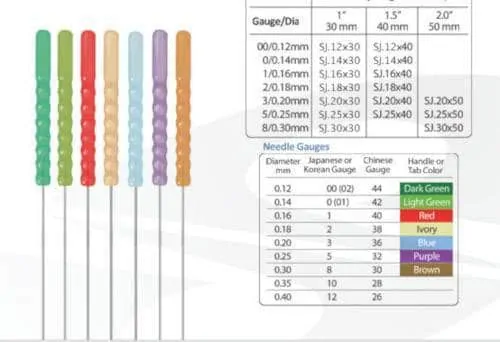
Or check this picture out
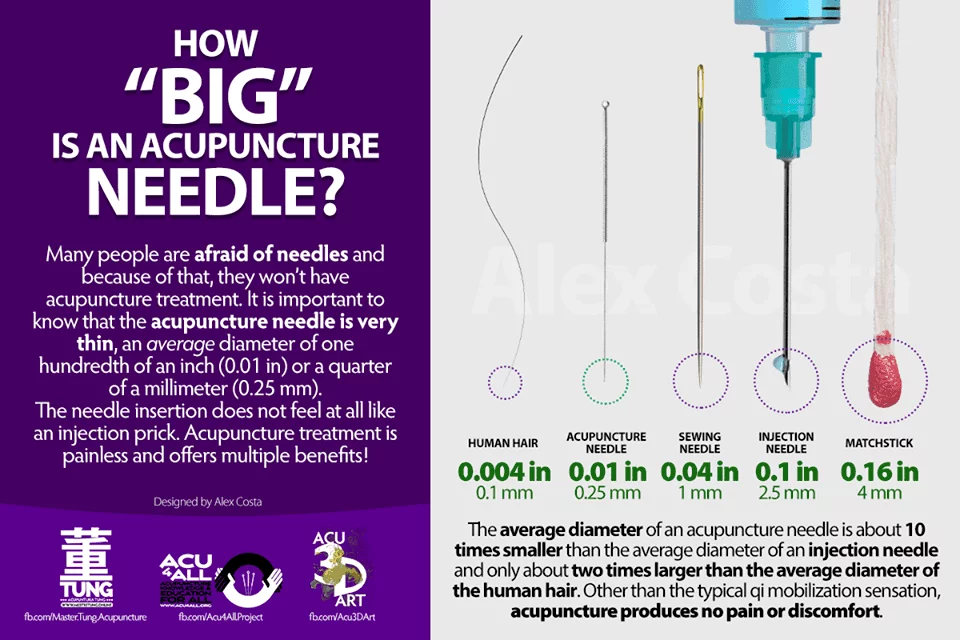
Up to how thick are acupuncture needles used today?
Some practitioners do follow more classical styles like what we are used to in the Han dynasty. It is not uncommon for them to use needles at 0.8mm thick, more closely resembling the classical size.
This size is around the same as a 21 guage hypodermic needle. These needles used in the Western medical profession for removing fluids or giving injection can be as thick as 5mm, though the most commonly used size is around 0.4-0.5mm!
For comparison, you can fit multiple acupuncture needles inside the tube of a hypodermic needle. Check out this video to see it in action!
What metal are acupuncture needles made of?
Disposable filiform needles used in acupuncture are made of surgical stainless steel. Some needles have a silicon coating to help with smoother insertion.
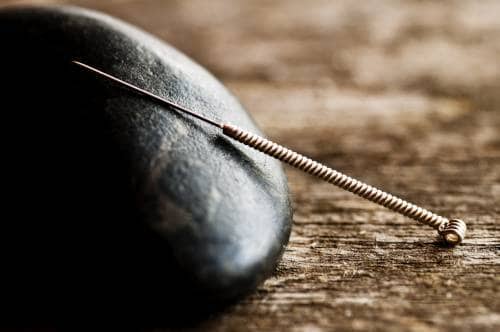
There are also acupuncture needles made of various materials like silver or gold (usually a composite), but these are not often used.
Some non-insertive acupuncture tools may be made of a wide variety of metals such as copper, titanium and others.
What were the first acupuncture needles made of?
It is believed that sharpened stones and bones were the first acupuncture ‘needles’ used in antiquity.
OK, thanks.
The question that I really want to ask though is:
Is acupuncture safe?
That’s a fair question to ask. It does generally involve the insertion of sharp objects.
Rest assured,
Acupuncture is generally safe when performed by experienced and qualified acupuncturists.
Remind me later to ask what you mean by experienced and qualified?
Will do!
What are the risks of acupuncture?
What modern research has told us is that:
Minor side effects occur in 7-13% of treatments
Serious side effects occur in less than 0.003% of treatments
What are minor side effects of acupuncture?
Minor acupuncture side effects are little to worry about. They may include minor adverse events such as bruising, bleeding, tiredness, local pain or a temporary worsening of symptoms.
The chances of these are minimized when careful diagnosis and well-practised needling skills are utilised in treatment. Studies have shown that these minor effects occur in around 7-13% of treatments performed 5 6.
What about the serious side effects of acupuncture?
As with any therapy that involves the skin there is also the potential for infection or piercing of an organ including serious events such as a pneumothorax.
Modern hygiene practices and the use of sterilised, single-use needles greatly reduces the chance for infection.
Adequate training that includes in-depth anatomical knowledge and many hours of closely supervised clinical practice is the best preventative for more serious events.
Serious side effects that require hospitalisation have been recorded as occurring in only 0.0001-.003% of treatments studied 5 6.
OK that doesn’t seem like it happens very often
No, they are extremely rare
In regards to the incidence of adverse events, Ernst et al, 2011, concluded that “The key to making progress would be to train all acupuncturists to a high level of competency”7.
Or to put that another way:
Acupuncture should only be performed by those with adequate training
Tweet it Out
I know that in our day acupuncturists were only paid when their patients were healthy. That they would be required to stay and restore health if illness struck. This would encourage the concept of using acupuncture as a preventative health measure.
Yes, that’s a good point you make. When the acupuncturist has to work for free if the patient got sick, it would really encourage them to teach them how to prevent illness!
I understand that it is not the same in modern practice. People pay for their treatments as they have them.
How much does acupuncture cost in Australia?
In Australia, the cost of acupuncture treatments ranges from $60-$120 per session for follow up appointments.
Usually, initial consultations cost a little more to allow time for more in-depth health history to be discussed and a treatment plan developed.
In student clinics and community acupuncture centres, the prices for acupuncture sessions are in the $30-$50 range.
That seems to be quite a range. Why does the cost of acupuncture vary so much?
It is difficult to give a precise answer around how much a session of acupuncture costs. This is because it is variable depending on the practitioner and clinic.
Some factors that may influence the cost of an acupuncture session include:
- Experience of the practitioner – those with more experience often charge more.
- Location of the practice – local socio-economic factors influence the cost of acupuncture
- Clinic environment – treatment may be in a private room or a shared, communal space. This affects the running costs for the acupuncturist.
- Style of practice – there are many different styles of practice. With them comes a variety of treatment flows. Some styles of acupuncture require the acupuncturist to spend the entire consultation with you. Other styles of practice may need you to rest undisturbed with needles in for a period of time. This allows the practitioner to attend to other patients at the same time.
- Other modalities practised – some practitioners incorporate other techniques within their acupuncture treatments. These may include cupping or moxibustion, or from other modalities such as counselling or craniosacral work.
I encourage you to read this recent survey into the cost of acupuncture for more information.
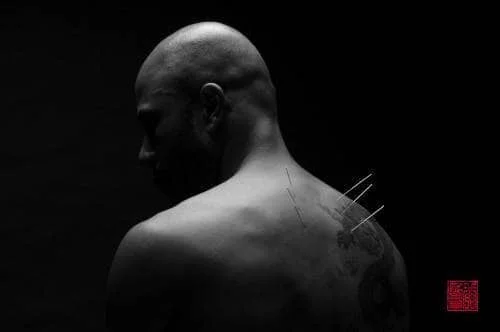
Oh right, that is a lot of different things to consider
Yes, there are a lot of factors involved.
For demonstration purposes to help you gain insight into the cost of acupuncture in Melbourne, have a look at the acupuncture price list from Dantian Health.
Some of the factors to consider influencing this clinic include:
- Treatment is in a private room.
- Jason has 10 years of experience working with people to achieve their health goals.
- Jason specialises in Nagano style acupuncture. This means he spends most of the consultation in the room, providing one on one attention.
- Jason also may incorporate other skills sets such as Tian family lineage herbalism, shiatsu or moxibustion into treatment
OK thanks for that, it helps me to understand.
Remember, a course of acupuncture treatment is an investment in your health.
When asking the question “how much does acupuncture cost”, you also must determine the cost of individual sessions and also how many sessions you may require.
You must also ask yourself:
What is the value to you in relieving your symptoms, reclaiming your health and restoring your vitality
Tweet it Out
Or to put it another way, what is the cost of not getting acupuncture treatment. You may find that it is hard to put a precise dollar value on this.
This can then help you to answer the question of whether acupuncture may be the correct treatment option for you.
Dantian Health – Melbourne Acupuncture and Chinese Medicine Clinic
Reclaim your health and restore vitality with responsive, holistic healthcare
OK, great thanks. I’ll be sure to book that in before he gets too busy!
So I’m going to be presumptive and assume I know what your next question is
What do you think I am going to ask next?
How many sessions of acupuncture do you need?
Well, of course, I would like to know how many acupuncture sessions I will need!
It is difficult to answer exactly how many acupuncture sessions are needed as this differs on a case by case basis. A general guideline for the number of acupuncture sessions needed is:
Acute cases: 3-6 treatments for a lasting resolution
Chronic cases: 6-10 treatments for positive changes, 10-20 sessions for consolidation of changes and more lasting changes
That doesn’t sound too bad if it will help me manage my health issues
There’s more info in this article on acupuncture dosage.
Also, remember to read this article around how to prepare for an acupuncture treatment to ensure you get the best out of those treatments
Thanks, I’ll be sure to check them out.
Can I get help with paying for my acupuncture treatments?
What do you mean?
Is acupuncture covered by Medicare in Australia?
Currently, the majority of acupuncturists are not covered by Medicare.
If the acupuncturist is a medical doctor, then there is a small rebate from Medicare. This is around $21.45 per session.
Medical doctors tend to practice a style of acupuncture known as medical acupuncture that requires less training. They also tend to use it as an additional tool, meaning their experience is more limited with acupuncture than full-time acupuncturists.
This is a consideration when selecting the best acupuncturist for you.
You can familiarise yourself with other things to think about in this guide to finding a great acupuncturist.
Is acupuncture covered by health insurance?
Most private health funds in Australia provide coverage for acupuncture under their extras packages. The refunded amount varies considerably depending on the level of cover.
While there have been recent changes to health fund rebates for natural therapies, acupuncture continues to be covered. You can read this to learn more about health insurance and acupuncture.
So all of this has got me pretty excited about acupuncture again.
I want to know…
How to become an acupuncturist in Australia?
Ahhh, you want to know how long it takes to become an acupuncturist!
To become an acupuncturist requires: a 4-5 year bachelors degree, ongoing professional development, a lifetime of practice!
Tweet it Out
Accredited training to become an acupuncturist in Australia involves a 4-5 year Bachelors degree in Health Science. This includes study in Western medical sciences as well as the underlying theories and of Chinese medicine.
These courses adhere to the Australian guidelines for education providers.
There are a few places that offer the study of an acupuncture course in Melbourne including:
A lot of emphases is placed on learning the modalities of acupuncture and herbal practice in a clinical environment. Education guidelines regarding acupuncture training in Australia state that there should be at least 500 hours of supervised clinical practice8.
This supervised clinical practice is critical to development as a practitioner and is what is absent in the plethora of dry needling courses available to practitioners of other modalities.
This is a public safety issue, as without this closely supervised needling practice the risk of adverse events increases.
Well yes, one would hope that people only learn a skill like this under close supervision.
Unless they are a registered acupuncturist, there is no guarantee that this has happened.
It sounds like acupuncture should only be performed by a properly educated and registered acupuncturist.
That pretty much sums it up!
It is imperative to ask questions of your practitioner about their training to ensure that only qualified professionals of this modality perform this powerful technique on you. This ensures that you can receive the safest and most effective treatments for your current health concerns.
Great point! I’ll be sure to ask any potential practitioners about their qualifications as an acupuncturist
So tell me then
Where can I find the best acupuncturist in Melbourne?
There are many great acupuncturists in Melbourne. Many can be found online.
Make sure you read this guide on how to choose the best acupuncturist.
Also remember that when browsing through google, searching based on reviews alone is not reliable. Acupuncturists are regulated in their advertising, meaning restrictions apply to testimonials .
Read this article around acupuncture reviews to understand a little more about it.
My recommendation is that you book in with Jason at Dantian Health. His Melbourne acupuncture clinic is in Brunswick, in the inner north.
Thanks!
No problem. It’s great to catch up with you. Let’s chat again soon!
Dantian Health – Melbourne Acupuncture and Chinese Medicine Clinic
Reclaim your health and restore vitality with responsive, holistic healthcare
What else would you like to know?
I hope you have enjoyed the conversation. Did they miss your question? Was something unclear? Are you itching to join in? Let me know if you found this useful in the comments below, I read and respond to them all!
DISCLAIMER
As an AHPRA registered practitioner, it is my duty to not be misleading in any advertising. So before my friends in the science in medicine crowd (Hi Ken!) and advertising regulators get too excited I must say the following.
This conversation didn’t actually take place. Whilst the information contained within is important and factually correct (to the best of my educated knowledge), this conversation is entirely fictional.
Amongst the many things I can do with Chinese Medicine, time travel is not one of them. What can I say – the DeLorean was out of petrol and I couldn’t get Bill and Ted on the phone!
REFERENCES
- Langevin HM, Churchill DL, Cipolla MJ. Mechanical signaling through connective tissue: a mechanism for the therapeutic effect of acupuncture. FASEB J. 2001 Oct;15(12):2275-82
- Li QQ, Shi GX, Xu Q, Wang J, Liu CZ, Wang LP Acupuncture effect and central autonomic regulation. Evid Based Complement Alternat Med. 2013;2013:2 doi 10.1155/2013/267959. Epub 2013 May 2
- Zhang ZJ, Wang XM, McAlonan GM. Neural acupuncture unit: a new concept for interpreting effects and mechanisms of acupuncture. Evid Based Complement Alternat Med. 2012;2012:429412. doi: 10.1155/2012/429412. Epub 2012 Mar 8
- Li P, Longhurst JC. Neural mechanism of electroacupuncture’s hypotensive effects. Auton Neurosci. 2010 Oct 28;157(1-2):24-30. doi: 10.1016/j.autneu.2010.03.015. Epub 2010 May 5.
- White, A. (2006). The safety of acupuncture – evidence from the UK. Acupuncture in Medicine, 24(Suppl), 53–57. https://doi.org/10.1136/aim.24.Suppl.53
- Linde, K., Streng, A., Hoppe, A., Jürgens, S., Weidenhammer, W., & Melchart, D. (2006). The programme for the evaluation of patient care with acupuncture (PEP-Ac) – a project sponsored by ten German social health insurance funds. Acupuncture in Medicine, 24(Suppl), 25–32. https://doi.org/10.1136/aim.24.Suppl.25
- Ernst, E., Lee, M. S., & Choi, T.-Y. (2011). Acupuncture: Does it alleviate pain and are there serious risks? A review of reviews. Pain, 152(4), 755–764.
- Janz S & Adams J, Acupuncture Education Standards in Australia – A Critical Review. Australian Journal of Acupuncture and Chinese Medicine, 2011, Vol.6, Iss.1
